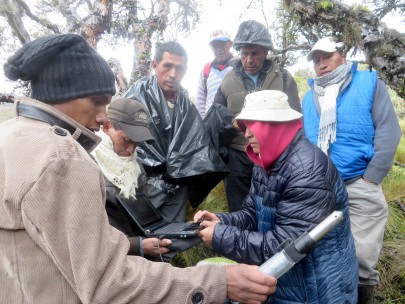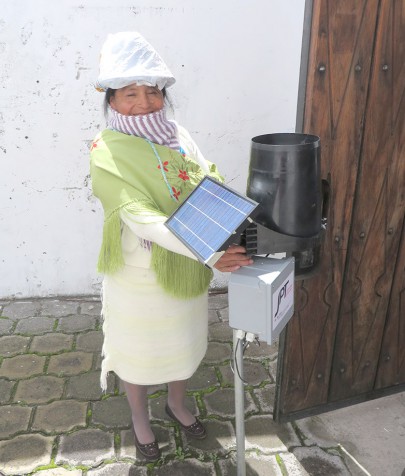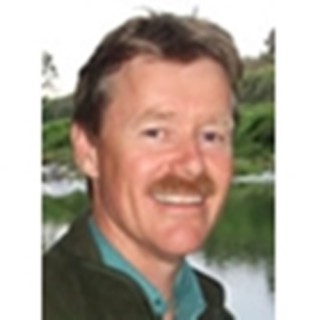While the tour was postponed, it’s still all go on the project that is lead by Manaaki Whenua and supported with funding from the New Zealand Ministry of Foreign Affairs and Trade’s Partnership’s Programme.

Marcia Chancusig (CESA) with Toacaso community members downloading river level data at a river monitoring site under Volcan Illinizas for planning a water supply scheme.
Now in its fifth year, the project Improving water resource management and use to enhance agricultural development in Colombia and Ecuador is a research and aid programme that loops in New Zealand research and funding with local NGO partners Corpopalo in Cauca, Colombia, and CESA in Cotopaxi, Ecuador.
Manaaki Whenua Senior Scientist, Andrew Fenemor says the goal of the project is to improve rural livelihoods for the largely indigenous communities in these two high altitude catchments.
“By applying knowledge from locally-generated land and water inventories, communities and agencies are showing real inspiration to improve the way they manage these steeplands and their water use, which in turn is building a sense of community and improvinge rural livelihoods and incomes.”
The project has set up water monitoring networks, is developing land suitability plans, advice and training, and economic development opportunities compatible with improved water and land management. “It’s about motivating local communities to improve their catchments while protecting upland paramo tussocklands, which generate much of the water needed down-catchment, says Andrew.
As part of the activities, the project has; established automated rainfall and river flow monitoring networks, completed surveys of water takes and land use, and used satellite mapping to relate landscape attributes to land use suitability.
These catchment inventories then provide the data to work with local communities to facilitate water sharing, reduce contaminant discharges, and improve land sustainability.
The work is already having an impact for communities in these areas, with the increased attention contributing to more funding and activity around water management. There have also been requests to apply the ICM approach in other catchment areas in both Colombia and Ecuador.
A key to the success of the project has been our Kiwi researchers' experience of working with Maōri. “There are similarities in ‘cosmovision’ for the natural environment between NZ and Colombian and Ecuadorean indigenous peoples,” says Andrew.
Andrew also praised the two project managers in the partner organisations who are both women and are providing inspiring leadership in heavily male dominated communities and agencies.

A woman from the local community with on of the original recording rain gauges (now more reliable solar charging and connected to web).
Because of COVID-19, the project will likely be extended for completion by the end of 2020.

